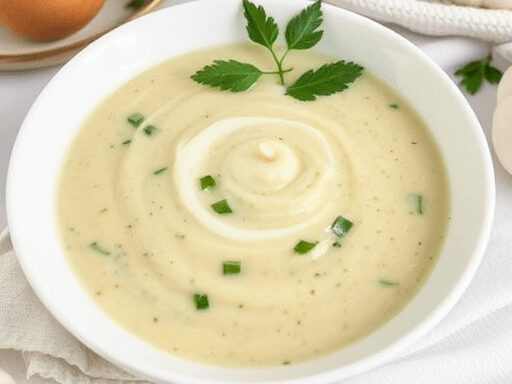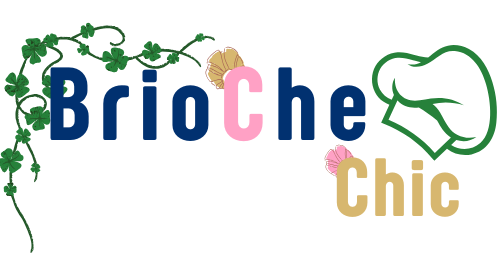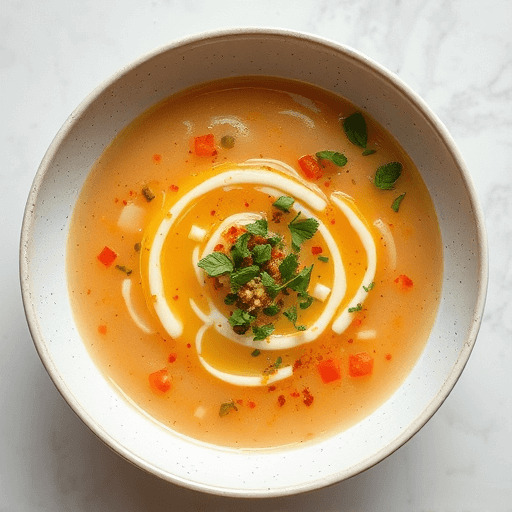In the hushed world of grand dining and timeless recipes, certain soups glide through history with their elegance undisturbed. Julienne soup, with its finely cut strands of vegetables, reflects a culinary style that values visual harmony as much as delicate flavor. Beside it stands Darblay soup, creamy and comforting — a nod to bourgeois tradition where soup was served with poise and pride.
These two recipes, rooted in the heritage of French cuisine, are quiet witnesses to a time when soup was a refined entrée, presented in delicate porcelain with ceremony. They also tell a story: one of craftsmanship, attention to detail, and a warm sense of shared simplicity.
In this article, I invite you to rediscover these classics through the Brioche Chic lens — where nostalgia meets elegance, and the everyday becomes quietly extraordinary. No need to reinvent the soup — sometimes, all it takes is serving it with love.
A Portrait of Potage Julienne
Light, structured, and precise — Potage Julienne is the soup equivalent of a string quartet. Each vegetable, carefully julienned, plays its part in a graceful composition. This is a dish that elevates knife work to an art form and simplicity to sophistication.
Far from rustic, Julienne is clarity in a bowl: a clear broth where every element is visible, intentional, and harmonious. It’s a dish that whispers refinement, perfect for those who appreciate the quiet luxury of tradition.
Originally crafted in the 18th century and named after the culinary cut itself, this potage is less about invention and more about execution. It reminds us that elegance is often found in restraint — and in a perfectly timed ladle.
Potage Darblay – The French Velouté
Potage Darblay is warmth in its most noble form: a gentle velouté made with leeks and potatoes, enriched with a touch of cream for a satin-like texture. It’s a soup that comforts without being heavy, perfect for cool days or to be served in a soup tureen at an elegant dinner.
What makes Darblay truly magical is its finishing touch: a bouquet of vegetables cut into julienne, sweated in butter. Carrots, celery, turnips, and leeks — all carefully prepared to delicately dance in the creamy velouté. It’s a meeting of rustic and refined, of everyday cooking and formal service.
At the Table:
The soup is served in a tureen, as tradition dictates, or in a warm soup bowl. The julienne is placed in the center, topped with the velouté, and finished with a sprig of fresh chervil for a green, aniseed-like touch. A hint of cream, if desired — and there you have it: a classic French dish in all its glory.
Technical Sheet – Darblay Soup with Julienne Garnish
Base Elements
| Ingredient | Quantity |
|---|---|
| Butter | 100 g |
| Leek whites | 400 g |
| Potatoes | 1.4 kg |
Finishing Touch
| Ingredient | Quantity |
|---|---|
| Cream | 100 ml |
| Chervil | ¼ bunch |
Julienne Garnish (vegetables sweated in butter)
| Ingredient | Quantity |
|---|---|
| Carrots | 200 g |
| Turnips | 150 g |
| Leek whites | 100 g |
| Celery stalk | 100 g |
| Butter | 50 g |
Seasoning
| Ingredient | Quantity |
|---|---|
| Coarse salt / Fine salt | To taste |
| Sugar | To taste |
Preparation Technique
- Peel and wash all vegetables carefully.
- Cook the base: sauté the leek whites and potatoes in butter, cover with water, and cook until tender.
- Cut the julienne: slice carrots, turnips, celery, and leek into fine, even matchsticks.
- Sweat the julienne in butter over low heat without browning, until soft yet structured.
- Blend the soup base, then strain or purée until smooth. Add the cream and adjust seasoning.
- Plate up in a warm soup tureen or bowl, gently placing the julienned vegetables in the center. Finish with fresh chervil.

A Final Sip – Timelessness in a Bowl
In a world of fleeting food trends and rapid reinvention, there’s something deeply grounding about a potage that has stood the test of time. Julienne and Darblay are not just soups — they’re quiet declarations of a culinary heritage where precision, patience, and respect for ingredients reign.
They remind us that elegance doesn’t need extravagance. That comfort can come in the form of a perfectly cut vegetable or a well-balanced velouté. And that sometimes, the most beautiful things are served warm, in silence, with a simple spoon.
So whether you’re ladling into porcelain for guests or sipping solo on a quiet afternoon, know that you’re partaking in a legacy — one bowl at a time
Everything You Wanted to Know About Potage Darblay (But Were Afraid to Ask)
Q: What makes Potage Darblay different from a classic leek and potato soup?
A: Potage Darblay is a refined version of the traditional leek and potato soup. What elevates it is its smooth, velvety texture — achieved by passing the soup through a fine sieve or blender — and its final enrichment with cream. It’s a soup designed for elegance, not rusticity.
Q: Is the julienne garnish essential?
A: Yes — the julienne of butter-sweated vegetables is a key component. It brings texture, color, and a subtle crunch that contrasts beautifully with the creamy soup. Think of it as a whisper of tradition and technique in every spoonful.
Q: Can I prepare Potage Darblay ahead of time?
A: Absolutely. The base can be made a day in advance and even frozen. Simply reheat gently and prepare the julienne fresh before serving for best texture and presentation.
Q: What’s the best way to serve it?
A: In a warm soup tureen or deep porcelain bowls. Garnish at the last moment with the julienne and a touch of fresh chervil. For an extra touch of chic: add a drizzle of cream or a crack of white pepper.

